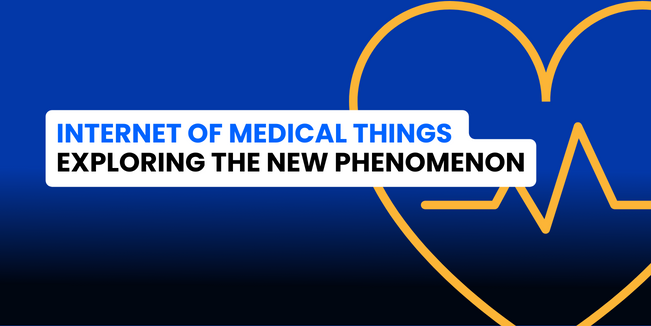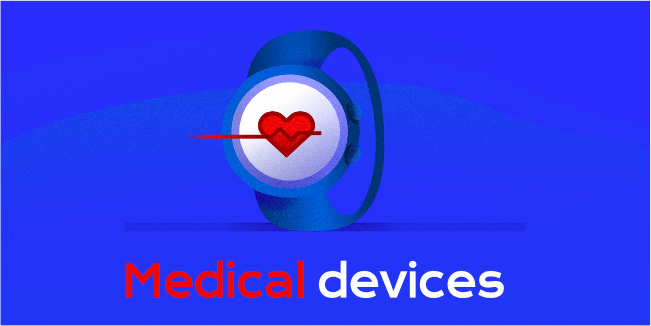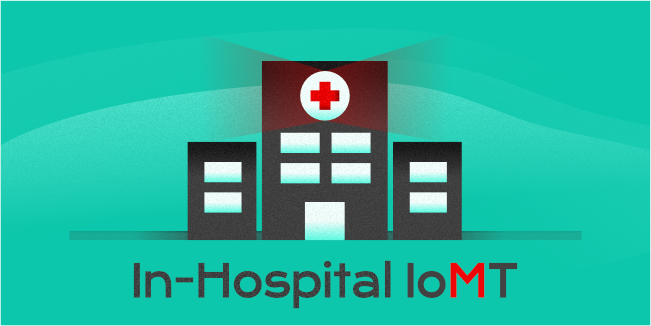Healthcare's Evolution: Exploring the IoMT Phenomenon

Today's world is full of technological innovations that change the landscape of our daily life. New technologies such as artificial intelligence (AI) or machine learning (ML) are increasingly used in solutions designed to facilitate everyday tasks. As a software development company, we understand that our duty is to follow the trends and provide our clients with a wide tech stack to create better and better products. Moreover, technology development enables cross-platform app development, which affects software project costs and development time.
In today's article, we will introduce you to the subject of the Internet of Medical Things (IoMT), which is changing the face of the medical industry, which is crucial for all people.
What is IoMT?
We are closer to technology than ever, and thanks to the Internet of Things, which we have already written about, we can connect various "smart" devices and tools to the network.
The Internet of Medical Things uses exactly this scheme, on which IoT is based. It means that smart devices collect data through various sensors, then send them to the cloud, where this data will be processed and returned to the application.
IoMT technology is an important step in the digital transformation of the healthcare market. According to a Deloitte report, the global IoMT market is expected to grow from $ 41 billion in 2017 to $ 158 billion in 2022! So this is a solution worth looking at.
IoMT uses the schemes we know from IoT to connect patients, nurses, doctors with data obtained through sensors mounted in smart devices. That's why IoMT is sometimes referred to as IoT in healthcare.
Smart IoMT devices such as blood pressure monitors, glucometers, and pulse oximeters collect data just like traditional devices, but getting data with smart devices is only the first step. The collected data is sent to the cloud, processed, saved, and returned to a dedicated application. In this way, medical personnel can remotely control the patient's health, which saves time and allows for a faster response in the event of health problems.
COVID-19 breakout only boosted the development of IoMT services. Technological solutions are changing the healthcare landscape faster and stronger than ever.
How is IoMT revolutionizing healthcare?
IoMT impacts many branches of the healthcare industry, after all, this solution has many uses. Let's look at 3 segments that are growing strongest.
In-house IoMT

The In-house IoMT segment allows sending patients' medical data at home to doctors or hospitals. In-House IoMT includes RPM, Telehealth, and PERS.
Remote patient monitoring (RPM)
Sensors to which the patient is connected can send data to a mobile application or web application on an ongoing basis so that the healthcare providers have a constant view of the patient data. It is a perfect solution in the case of chronic diseases because the patient does not have to travel to a hospital far away from home frequently. Moreover, thanks to this solution, it is possible to predict the deterioration of the patient's condition, and the patient's experience will be much better.
Our remote patient monitoring realization
In the Scandinavian countries, the healthcare sector is confronted with problems such as an aging population and huge distances between patients’ houses and hospitals. Therefore systems that use internet-connected medical devices are the way to go!
We at mDevelopers had the pleasure of creating such a system for the Norwegian health service.
Our Norwegian client decided to build an IoMT system, in which the main task would be to monitor patients' examination results at a distance. Our solution consisted of a mobile application created from scratch, which obtained data from sensors placed in the scale, blood pressure meter, and pulse oximeter. These devices were wirelessly transmitting data to a mobile application via Bluetooth Low Energy connection.
Afterward, the collected data, charts, and patients’ health information are sent to the doctor, who can adequately manage the treatment by accessing the data. The patient can be treated remotely without the need for in-person hospital visits.
Additionally, such a solution enables constant monitoring of the patients’ health conditions by aggregating historical data, different generations, and updating charts, which reduces the risk of making mistakes or missing important information about the patients’ health.
Our Norwegian healthcare client achieved such benefits as faster accurate diagnoses of patients, reduced costs connected with dispensable patients’ visits, transparency, and reliability.
Our implementation reflects what the IoMT ecosystem is - a way to improve patient experience and modernize health care systems, thanks to internet-connected devices.
Telehealth
Telehealth is often connected with RPM because when a doctor gets our medical IoMT data and decides something is wrong or wants to ask how we are feeling, they can do it via videoconference or a phone call. This solution also allows for remote drug management by prescribing personalized medicines. At the time of covid-19, when doctors could not always accept in-person medical visits, telehealth became the new standard.
Our "Telemedicine App Development Guide" article discussed this issue in detail.
Personal emergency response systems (PERS)
PERS is a solution intended mainly for high-risk groups, such as seniors. Medical equipment (most often wearable) can detect an emergency, such as a heart attack or fall, and can independently call an ambulance because it is connected to an emergency number. In this way, patient care is at the highest level, even if no one is around the patient.
Wearable medical devices

This segment includes all wearable smart devices that can measure our health. A large proportion of people, for example, have an Apple Watch, which is a smartwatch, of course, but it can also be seen through the prism of a medical device because it can measure our pulse and warn us if our heart rhythm is disturbed.
Likewise, the blood pressure monitor that shows and stores our results in the application is an IoMT solution. All devices showing us the health condition that we can buy ourselves in the store are consumer-grade wearables.
However, devices such as holter or glucose sensors are already classified as clinical-grade wearables because the doctor orders us to use them, and we use them under his care. Clinical wearables have much more accurate measurements than consumer-grade wearables, often send data immediately to healthcare professionals, and are certified by health authorities.
In-Hospital IoMT

All IoMT solutions that are used in hospitals belong to this segment, from medical equipment that monitors patients on an ongoing basis and sends notifications if the patient's condition worsens, through sensors that show whether a given patient's room is occupied, to the IDs of medical personnel, that are able to control their location, and set off an alarm if, for example, the patient is aggressive.
We already have large health systems globally that largely operate on healthcare IoT to provide care providers and patients with a better experience. Connected infrastructure in healthcare organizations allows them to treat patients better than ever, and medical care professionals can perform medical services seamlessly.
What are the benefits of IoMT?
IoMT has many benefits for patients and organizations using such solutions. Not without reason, the market related to both IoT and IoMT is constantly growing, and new solutions appear every day. So let's first look at the advantages of IoMT for patients.
Advantages for patients
More accurate diagnoses
When we come to the doctor, we don't have all of our medical data, and most often, we don't have it at all. Therefore, the doctor performs tests and measurements on the spot. Using the IoMT device, we can monitor our health status on an ongoing basis, and in the case of medical visits, show the collected information so that the doctor has more information based on which he comes with the diagnosis.
Treatment even at remote locations
As we showed in the example of our cooperation with the Norwegian health service, IoMT can be a solution that provides the best standard of medical care without leaving your home. Devices with sensors and software applications are enough to receive a diagnosis or a further treatment plan.
Constant access to data
Many of us lead a busy lifestyle, so we often don't have time to sign up for checkout. IoMT devices allow us to control our health condition without making an appointment with a specialist. However, if we are already under the care of a specialist, he can monitor our health on an ongoing basis.
Advantages for organizations
Better patient control
Patients with chronic diseases who need to be constantly monitored take a long time for medical staff. By using IoMT, we can control the condition of such patients, even if they are outside the hospital. But even in a hospital, IoMT allows for better patient monitoring because all the equipment can be connected to the network so that medical staff can view patients' data without checking each patient's condition.
Reduced costs
Implementing IoMT technologies allows for a significant reduction in costs because fewer people are needed to control patients. The patients themselves have to visit their care provider much less often. Thanks to the constant monitoring of patients' health, the risk of sudden deterioration of health, resulting in hospitalization, is reduced. Patients avoid the emergency rooms and care providers save the budget.
Better Asset Management
All innovative equipment connected to the network can also have a GPS module so that medical staff will always know where the equipment is located. Even "normal" hardware such as wheelchairs can be plugged into the network to locate it quickly if necessary. Additionally, the hardware can analyze itself and let you know if something is malfunctioning.
Healthcare applications
For IoMT solutions to work, they must send the collected data to the application. After all, the process in both IoT and IoMT looks like this:

- Data from smart device sensors are acquired,
- Data is sent to the cloud,
- The data is analyzed and saved,
- The data goes to the application.
Without a well-designed application, the data will have nowhere to appear, so the whole project will be pointless. Considering that we are dealing with human health, the application must be transparent and error-free.
Summary
Medical applications can be decisive for a person's life and health. Therefore, it is best to outsource their creation to experienced specialists from the programming industry.
At mDevelopers, we have over 12 years of experience in this field, and our portfolio is full of successful projects. Please visit our free consultation if you want to learn more about how IoMT can help you!